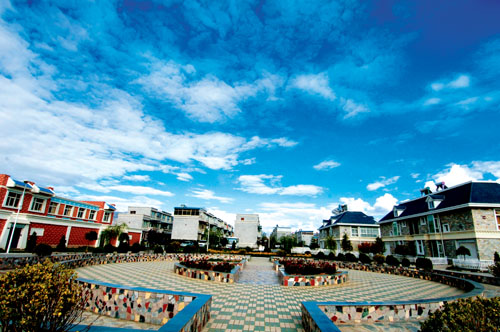|
 A new residential quarters in Lhasa.
A new residential quarters in Lhasa.
Before the peaceful liberation in 1951, Tibet, a land-locked region, had no modern industry. The locals lived on livestock breeding, farming and handicraft business. Since the democratic reform in 1959, and especially the reform and opening up policy carried out from 1978, the Tibet Autonomous Region has accelerated its economic construction, not only establishing modern industry and transport and telecommunications service sectors, but also making much headway in the original agriculture, animal husbandry and forestry sectors, and commerce. Recent years have seen the TAR thoroughly apply the Scientific Outlook on Development, and continue to emancipate minds in a pioneering and enterprising spirit. In line with the economic development strategy of "elevating the level of primary industry, setting great store by the key sectors in secondary industry and making considerable progress in tertiary industry", the region has speeded up the transformation of the economic development mode to boost its self-development capability. As a result, the economy of the region runs smoothly with more benefits and outstanding effects. The whole region is rapidly experiencing economic and social development.
According to the Statistical Communiqué of the Tibet Autonomous Region on 2007 National Economy and Social Development, GDP in Tibet reached 34.219 billion Yuan, an increase of 14 percent over 2006 and exceeding the predicted amount. The added value of primary industry was 5.533 billion Yuan, up 4.3 percent, that of secondary industry 9.657 billion Yuan, up 15.9 percent, and that of the tertiary sector was 19.029 billion Yuan, up 16.2 percent. Per capita GDP hit 12,109 Yuan, a rise of 12.6 percent.
The added value of the three sectors contributed 16.2 percent, 28.2 percent and 55.6 percent respectively of GDP. Compared with the previous year, the figures represented a fall of 1.3 percentage points for primary industry, and an increase of 0.7 and 0.6 percentage points for the secondary and tertiary sectors respectively.
The economy of Tibet in 2007 featured "one transformation, two breakthroughs and three accelerations".
One transformation: The social consumption level showed a remarkable increase; consumption played a more important role in fueling economic development. The driving force for economic growth was transformed from major investment to a mix of investment and consumption. However, investment is still the dominant force promoting economic growth in Tibet, which is unlikely to change fundamentally in the short term.
Two breakthroughs: The gross regional product surpassed 30 billion Yuan. The growth rate has stayed above 12 percent for seven straight years, creating a record high since the Ninth Five-Year Plan. The total retail sales of consumer goods hit 11.2 billion Yuan, an increase of 24.9 percent and the fastest growth in 20 years.
Three accelerations: Industry enjoyed a faster growth rate, gaining preliminary effects due to stressing key sectors. The annual added value of industry reached 2.571 bullion Yuan, a rise of 17.7 percent. Tourism developed faster, recording 4.02 million person/times, a rise of 60 percent. The per capita net income of farmers and herders amounted to 2,788 Yuan, up 14.5 percent or some five percentage points higher than the national average.
In 2007, Tibet continued increasing its efforts to attract outside investment. A total of 328 various projects concerning outside investment were signed, with a capital on agreement of 22.68 billion Yuan. Actual utilized capital reached 4.656 billion, or 116.4 percent of the expected figure at the beginning of the year and a rise of 26 percent from the previous year. By the end of the year, the quantity of the individual units of industry and commerce in Tibet Autonomous Region reached 77,051 with 167,000 employees and registered capital of 1.86 billion Yuan, increased of 12.21, 24 and 29.9 percent respectively. The number of private enterprises reached 4,236 with 81,000 employees and registered capital of 13.96 billion Yuan, up 24.08, 58.72 and 45.8 percent respectively. The economic structure of Tibet was further optimized, opening wider to the outside world.
(China's Tibet Facts and Figures 2008) |
